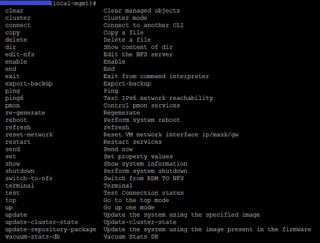We recently had to restart the Cisco UCS Central VM (ver. 1.5). I couldn't find a way through the Web Management Portal/GUI, so a Shutdown was performed through the console.
1. As a precaution, create a VMware snapshot.
2. SSH into the Cisco UCS Central VM using the admin credentials.
3. Then, switch the context to local-mgmt:
4. Below are the options available within this context. Note - shutdown and restart.
5. Enter the shutdown (or restart) option. Enter yes to confirm.
I'm a Sr. Systems Engineer at a Global Environmental Engineering company. I've been in IT since 1999 and from 2005, my focus has been VMware datacenter products. More recently, my attention has been for Microsoft Azure services. As the Global Service Owner for VMware Datacenter products, I've had the pleasure of having in-depth and hands-on experience with not only VMware products, but server, storage and networking technologies.
Wednesday, January 11, 2017
Monday, January 9, 2017
Nissan Vmotion 2.0 - VMWare vMotion
As a user of VMware products for over a decade, the following article made me chuckle.
http://www.caranddriver.com/news/nissan-vmotion-20-concept-photos-and-info-news
My co-worker said the Nissan Vans should be called "Storage Vmotion". Har har.
http://www.caranddriver.com/news/nissan-vmotion-20-concept-photos-and-info-news
My co-worker said the Nissan Vans should be called "Storage Vmotion". Har har.
Wednesday, January 4, 2017
vMotion Error: A general system error occurred: The source detected that the destination failed to resume.
This past weekend, a VM had unexpectedly powered off (Of course on Jan 1st, Yay me! ). I was able to successfully power on the VM and confirmed the application was up and running.
However, I noticed that a vMotion that was kicked off by VMTurbo/Turbonomics had failed. (I'm still getting used to their new name).
The error was:
This was similar to the following KB, but in my case the VM was powered on. For completeness, I also did not have any snapshot/delta files for the VM.
https://kb.vmware.com/selfservice/microsites/search.do?language=en_US&cmd=displayKC&externalId=2009244
Unfortunately, I had to coordinate the down time to resolve this issue. Once I received the approval, here are the steps I took:
1. Gracefully shut down the VM.
2. Note the offending .vmdk file in the error message. Capture the SCSI Controller type AND the Virtual Device Node of the offending .vmdk/Hard Disk.
3. SSH in the host and drill down to the folder containing the VM. Once again, I did not have any snapshot files for this particular VM.
4. Use the Move (mv) command to rename the ctk file of the offending vmdk.
ex. mv myvm-ctk.vmdk myvm-ctkold.vmdk.
5. Re-add the disk to the VM using the appropriate Virtual Device Node using the vSphere Client.
6. Edit the offending .vmdk descriptor file by commenting out any references that specify the use of a ctk file.
7. Power on VM.
8. Test VM functionality. vMotion, creating/deleting snapshots etc.
Apparently the cause cause of this issue is when the filename-ctk.vmdk file is not cleared. No reason was given as to what caused this in the first place.
However, I noticed that a vMotion that was kicked off by VMTurbo/Turbonomics had failed. (I'm still getting used to their new name).
The error was:
The
VM failed to resume on the destination during early power on.
Module
DiskEarly power on failed.
Cannot
open the disk
'/vmfs/volumes/myvm/myvm/myvm.vmdk'
or one of the snapshot disks it depends on.
Could
not open/create change tracking file
This was similar to the following KB, but in my case the VM was powered on. For completeness, I also did not have any snapshot/delta files for the VM.
https://kb.vmware.com/selfservice/microsites/search.do?language=en_US&cmd=displayKC&externalId=2009244
Unfortunately, I had to coordinate the down time to resolve this issue. Once I received the approval, here are the steps I took:
1. Gracefully shut down the VM.
2. Note the offending .vmdk file in the error message. Capture the SCSI Controller type AND the Virtual Device Node of the offending .vmdk/Hard Disk.
3. SSH in the host and drill down to the folder containing the VM. Once again, I did not have any snapshot files for this particular VM.
4. Use the Move (mv) command to rename the ctk file of the offending vmdk.
ex. mv myvm-ctk.vmdk myvm-ctkold.vmdk.
5. Re-add the disk to the VM using the appropriate Virtual Device Node using the vSphere Client.
6. Edit the offending .vmdk descriptor file by commenting out any references that specify the use of a ctk file.
7. Power on VM.
8. Test VM functionality. vMotion, creating/deleting snapshots etc.
Apparently the cause cause of this issue is when the filename-ctk.vmdk file is not cleared. No reason was given as to what caused this in the first place.
Subscribe to:
Comments (Atom)






